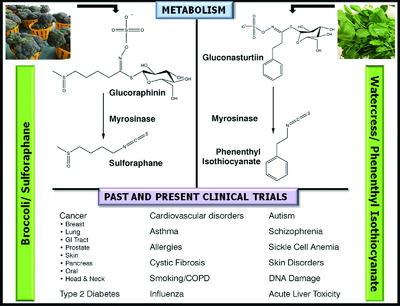当前位置:
X-MOL 学术
›
Mol. Nutr. Food Res.
›
论文详情
Our official English website, www.x-mol.net, welcomes your
feedback! (Note: you will need to create a separate account there.)
Isothiocyanates: Translating the Power of Plants to People
Molecular Nutrition & Food Research ( IF 4.5 ) Pub Date : 2018-03-26 , DOI: 10.1002/mnfr.201700965 Dushani L Palliyaguru 1 , Jian-Min Yuan 2, 3 , Thomas W Kensler 1, 3 , Jed W Fahey 4
Molecular Nutrition & Food Research ( IF 4.5 ) Pub Date : 2018-03-26 , DOI: 10.1002/mnfr.201700965 Dushani L Palliyaguru 1 , Jian-Min Yuan 2, 3 , Thomas W Kensler 1, 3 , Jed W Fahey 4
Affiliation

|
Isothiocyanates from cruciferous vegetables have been studied extensively in cells and in animals for their disease preventive and therapeutic effects. However, translating their utility to human populations has been both limited and challenging. Herein, clinical trials employing two isothiocyanates, sulforaphane (SFN; 1‐isothiocyanato‐4‐(methylsulfinyl) butane) and phenethyl isothiocyanate (PEITC; 2‐isothiocyanatoethylbenzene) that are isolated principally from broccoli and watercress, respectively, are summarized and discussed. Both of these compounds have been used in small human clinical trials, either within food matrices or as single agents, against a variety of diseases ranging from cancer to autism. Results suggest an opportunity to incorporate them, or more likely preparations derived from their source plants, into larger human disease mitigation efforts. The context for the applications of these compounds and plants in evidence‐based food and nutritional policy is also evaluated.
中文翻译:

异硫氰酸盐:将植物的力量转化为人类
十字花科蔬菜中的异硫氰酸盐的疾病预防和治疗作用已在细胞和动物体内进行了广泛研究。然而,将它们的效用转化为人类既有限又具有挑战性。本文总结并讨论了使用两种异硫氰酸酯、萝卜硫素(SFN;1-异硫氰酸根-4-(甲基亚磺酰基)丁烷)和异硫氰酸苯乙酯(PEITC;2-异硫氰酸乙苯)的临床试验,这两种异硫氰酸酯主要从西兰花和西洋菜中分离出来。这两种化合物均已用于小型人体临床试验,无论是在食品基质中还是作为单一药物,用于治疗从癌症到自闭症等多种疾病。结果表明有机会将它们,或更可能是从其来源植物中提取的制剂,纳入更大的人类疾病缓解工作中。还评估了这些化合物和植物在循证食品和营养政策中的应用背景。
更新日期:2018-03-26
中文翻译:

异硫氰酸盐:将植物的力量转化为人类
十字花科蔬菜中的异硫氰酸盐的疾病预防和治疗作用已在细胞和动物体内进行了广泛研究。然而,将它们的效用转化为人类既有限又具有挑战性。本文总结并讨论了使用两种异硫氰酸酯、萝卜硫素(SFN;1-异硫氰酸根-4-(甲基亚磺酰基)丁烷)和异硫氰酸苯乙酯(PEITC;2-异硫氰酸乙苯)的临床试验,这两种异硫氰酸酯主要从西兰花和西洋菜中分离出来。这两种化合物均已用于小型人体临床试验,无论是在食品基质中还是作为单一药物,用于治疗从癌症到自闭症等多种疾病。结果表明有机会将它们,或更可能是从其来源植物中提取的制剂,纳入更大的人类疾病缓解工作中。还评估了这些化合物和植物在循证食品和营养政策中的应用背景。











































 京公网安备 11010802027423号
京公网安备 11010802027423号